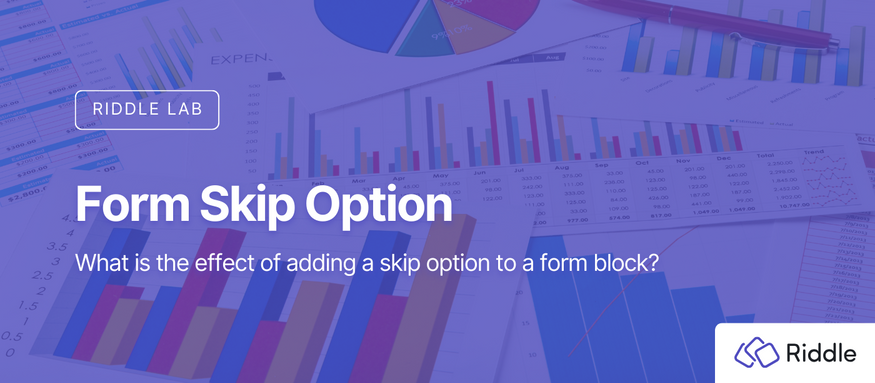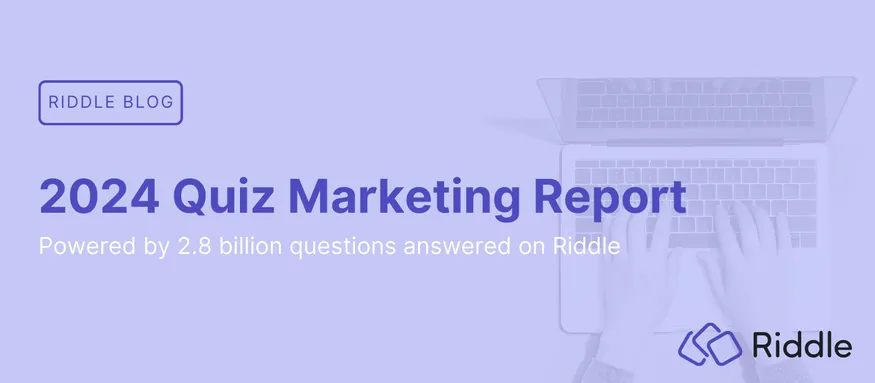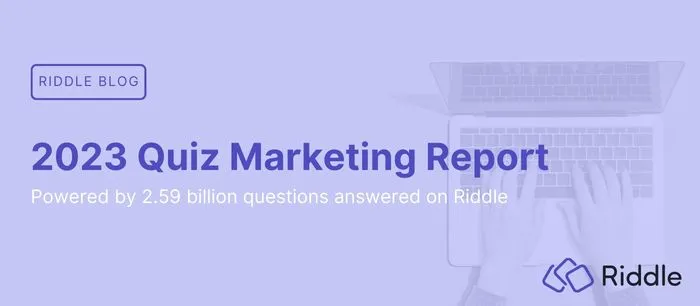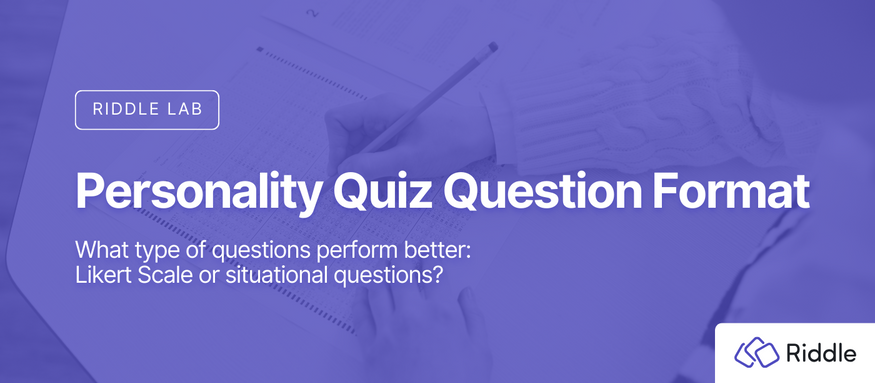Experiment: Skippable vs. Unskippable Forms
What is the effect of adding a skip option to a form block on its completion rates?
Introduction
Building a list of newsletter subscribers through zero party data is the most cost efficient way to reach existing and new customers and readers.
When creating sign up forms, you are faced with a difficult choice:
Should you make filling out a form mandatory in order to proceed to the next page or your quiz results or should a form be skippable, allowing readers to get to their results without signing up for your newsletter.
Both options have their pros and cons.
Skippable forms should reduce the amount of fake email entries and are more user friendly. Mandatory forms should have a much higher completion rate but you will need to account for users entering a fake address to bypass the form.
In this Lab experiment, we will uncover valuable insights that will help optimize lead acquisition strategies and help you create the ideal Riddle.
We designed two identical Riddles but added a crucial variation: the form block.
In one version, the form block was mandatory (unskippable), meaning users had to complete it before accessing the results. In the other version, we allowed users to skip the form block if they wished to.
Call To Action
Before we get started we’d like to explain the approach we took regarding the CTA briefly.
We purposely kept away from persuasive tactics which force users to provide their information. Instead, our aim was to engage users by igniting their personal interests and motivating them to become experts.
This approach not only tends to attract more leads but also generates more authentic and trustworthy information. We will go into more depth about this in a future experiment and explore the different options.
Answering the following questions:
- Does the addition of a “skip option” affect the number of leads generated?
- Are there differences in the level of interest or engagement demonstrated by leads obtained from skippable and unskippable forms?
- Are users more inclined to complete the Riddle when presented with a skippable form compared to an unskippable form?
Key considerations when deciding on a form skip option
- Lead Quantity:
Our primary metric for comparison will be the number of leads generated by each Riddle. By analyzing the data, we can determine whether the presence of a skippable or unskippable form has a significant impact on the volume of successful leads. - Lead Quality:
It’s crucial to examine the characteristics of the leads obtained from both Riddles. Are there any differences in their level of interest, engagement, or intent? Understanding these distinctions will help us gauge the effectiveness of each form in attracting valuable leads. - User Experience:
We’ll closely evaluate the user experience associated with each form type. Does the presence of a skippable form make users more inclined to complete the Riddle? Are there any noticeable differences in user satisfaction or dropout rates?
These insights will guide us in optimizing future lead-generation strategies and enhancing the overall user experience.
Results for the form skip option
Let’s look into the results of the A/B test examining the impact of a skippable vs. unskippable form block.
We can then try to understand how the option to skip the form block influenced user engagement and completion rates.
The Chi-Square Test
This is a statistical method to compare categorical data such as completion rates across different groups.
It helps determine if there is a statistical difference between the two sets of data – in this case, the two sets were the skippable and unskippable form blocks.
In this case, the chi-square test was performed to compare the distributions of completed leads and uncompleted leads (skips) between the two Riddles.
Summarizing the results it is clear that the unskippable form block overall achieves better results.
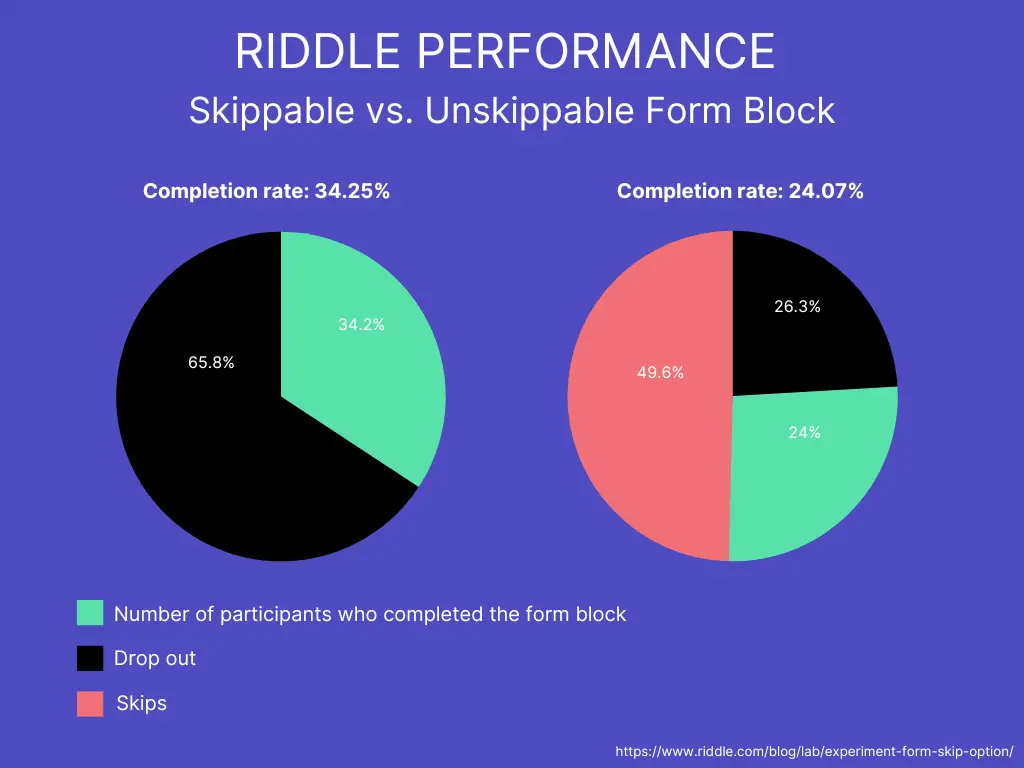
Unskippable form block
- Total participants who reached the form block: 146
- Number of participants who completed the form: 50 (34%)
- Number of participants who left the quiz without seeing the results: 96 (66%)
- Completion Rate: 34.25%
Skippable form block
- Total participants who reached the form block: 270
- Number of participants who completed the form: 65 (24%)
- Number of participants who skipped the form: 134 (50%)
- Number of participants who left the quiz without seeing the results: 71 (26%)
- Completion Rate: 24.07%
Conclusion
While offering flexibility through skip options may seem appealing, it may negatively impact completion rates. Giving them the freedom to choose whether to complete the form or not showed decreased lead generation.
Offering skip options can be advantageous in certain scenarios, but for critical sections, consider making them unskippable to maintain participant interest and enhance Riddle completion rates.
Does the skip option of the form block influence lead quality?
Our study revealed that the form block option – skippable or unskippable – did not impact the quality of leads generated.
We examined the email addresses collected and found that both quizzes produced the same percentage of valid and authentic email addresses.
This unexpected finding suggests that participants who were hesitant to provide their information chose to drop out of the quiz rather than submit fake or invalid details.
Understanding the impact of these small yet pivotal elements can drive better results and higher fill-in rates. This enables you to connect more effectively with our audience.
Further reading
Our annual quiz marketing report provides key benchmarks for quiz conversions with data taken from over 3 billion quiz questions.
